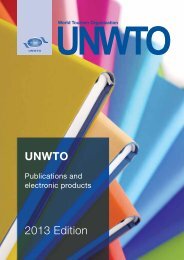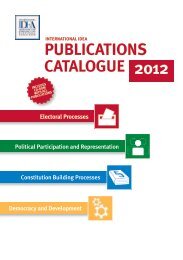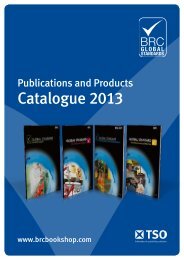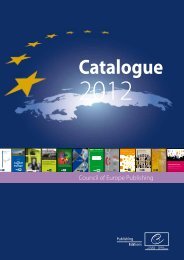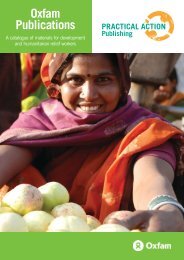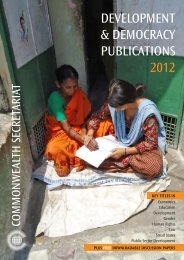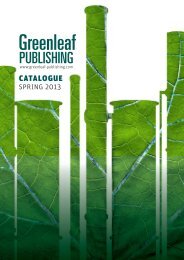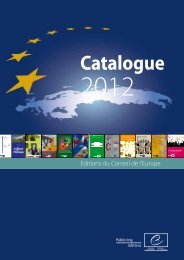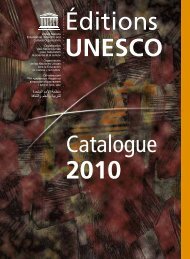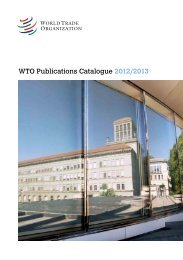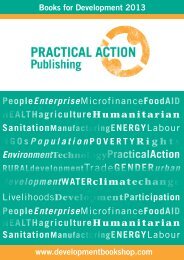UNESCO 2010/11 - Renouf Publishing Co. Ltd.
UNESCO 2010/11 - Renouf Publishing Co. Ltd.
UNESCO 2010/11 - Renouf Publishing Co. Ltd.
You also want an ePaper? Increase the reach of your titles
YUMPU automatically turns print PDFs into web optimized ePapers that Google loves.
GENERAL REFERENCE WORKS<br />
9<br />
GENERAL<br />
REFERENCE<br />
WORKS<br />
Profile series<br />
Joseph Needham<br />
20th-Century Renaissance Man<br />
Maurice Goldsmith<br />
Profile series<br />
1995, 180 pp., illus. in black and white<br />
24 × 13 cm<br />
ISBN 978-92-3-103192-2<br />
€ 18.30<br />
<strong>UNESCO</strong> <strong>Publishing</strong><br />
The Sasia Story<br />
Told by Madanjeet Singh<br />
Foreword by Koïchiro Matsuura, Director-General of<br />
<strong>UNESCO</strong><br />
Introduction by Manmohan Singh<br />
Profile series<br />
2005, 224 pp., colour photographs, 25 × 20 cm<br />
ISBN 978-92-3-103992-8<br />
€ 15.00<br />
<strong>UNESCO</strong> <strong>Publishing</strong>/South Asia Foundation<br />
The Sasia Story recounts Madanjeet Singh’s<br />
lifelong search for economic stability and<br />
regional cooperation. It is the story of a young<br />
man’s activism and fervour, as well as the trauma<br />
he suffers in the aftermath of partition and<br />
the gruesome fratricidal conflict between India<br />
and Pakistan. Madanjeet Singh is a <strong>UNESCO</strong><br />
Goodwill Ambassador. He established the<br />
Sumitra Foundation (SF) in 1995, which holds<br />
firm the conviction that without education<br />
and family planning alleviation of poverty<br />
is impossible. In 2000, he also set up the<br />
South Asia Foundation (SAF), which is a<br />
non-profit, non-political and secular youth<br />
movement created to benefit disadvantaged<br />
and marginalized communities in Afghanistan,<br />
Bangladesh, Bhutan, India, Maldives, Nepal,<br />
Pakistan and Sri Lanka. The objectives of SF and<br />
SAF are two sides of the same coin, the theme of<br />
The Sasia Story.<br />
<strong>UNESCO</strong> has exclusive sales rights except in India<br />
Also published in French: L’histoire du Sasia,<br />
and in Spanish: La historia del Sasia<br />
<strong>UNESCO</strong> Reference<br />
Works series<br />
NEW<br />
INSTITUTE for STATISTICS<br />
<strong>UNESCO</strong><br />
Special focus on gender<br />
GLOBAL EDUCATION DIGEST <strong>2010</strong><br />
<strong>Co</strong>mparing Education Statistics Across the World<br />
Global Education Digest <strong>2010</strong><br />
<strong>Co</strong>mparing Education Statistics Across the World<br />
<strong>UNESCO</strong> Reference Works Series<br />
<strong>2010</strong>, 276 pp., figures, boxes, statistical tables, annexes,<br />
glossary, 28 × 21.5 cm<br />
ISBN 978-92-9189-088-0<br />
€ 25.00<br />
<strong>UNESCO</strong>-UIS<br />
The <strong>2010</strong> Global Education Digest focuses<br />
specifically on gender and education to mark<br />
“Beijing +15” – the 15th anniversary of the<br />
Fourth World <strong>Co</strong>nference on Women. This<br />
edition presents a rich set of cross-nationally<br />
comparable data compiled by the UIS as well<br />
as information from household surveys and<br />
assessments of learning achievement that capture<br />
the scope of gender disparities across the world.<br />
The international community pledged to eliminate<br />
gender disparities in all levels of education by<br />
2015 as part of the Millennium Development<br />
Goals (MDGs). Yet 63% of countries (out of<br />
157 with available data) are still faced with gender<br />
disparities in primary and secondary education<br />
and these imbalances will probably persist in<br />
nearly half of countries in 2015.<br />
The Digest presents a wide range of education<br />
indicators and data for the school year ending<br />
in 2008 or the latest available year, as well as<br />
data for 2009 for a small number of countries.<br />
It includes data tables from the World Education<br />
Indicators programme, which are comparable<br />
across a group of 62 countries. These indicators<br />
can help benchmark the performance of national<br />
education systems.<br />
Also published in French: Recueil de données mondiales<br />
sur l’éducation <strong>2010</strong><br />
Financing Education – Investments<br />
and Returns<br />
Analysis of the World Education Indicators - 2002 Edition<br />
<strong>UNESCO</strong> Reference Works series<br />
2003, 230 pp., graphs, statistical tables, 27 × 20.5 cm<br />
ISBN 978-92-9189-001-9<br />
€ 19.00<br />
<strong>UNESCO</strong>-UIS/OECD<br />
Global Education Digest 2009<br />
<strong>Co</strong>mparing Education Statistics Across the World<br />
<strong>UNESCO</strong> Reference Works Series<br />
2009, 262 pp., figures, boxes, statistical tables, annexes,<br />
glossary, 28 × 21.5 cm<br />
ISBN 978-92-9189-070-5<br />
€ 25.00<br />
<strong>UNESCO</strong>-UIS<br />
The 2009 Global Education Digest (GED)<br />
presents a wide range of education indicators to<br />
assess progress towards Education for All and<br />
Millennium Development Goals. These crossnationally<br />
comparable indicators also provide<br />
benchmarks for the performance of national<br />
education systems.<br />
The Digest provides data for the school year<br />
ending in 2007 or the latest year available, as<br />
well as data for 2008 for a small number of<br />
countries. It includes data tables from the World<br />
Education Indicators (WEI) programme, which<br />
are comparable across a group of 62 countries,<br />
including those that are members of the<br />
Organisation for Economic <strong>Co</strong>-operation and<br />
Development (OECD). In addition, time series<br />
data on tertiary education from 1970 onwards<br />
are presented.<br />
The special focus of this edition is the analysis<br />
of emerging global trends in tertiary education,<br />
highlighting the rapid growth of tertiary<br />
education systems since 1970, changing patterns<br />
in tertiary education graduates by field of study,<br />
and in particular, the changing landscape of<br />
international student mobility.<br />
Also published in French: Recueil de données mondiales<br />
sur l’éducation 2009<br />
Global Education Digest 2008<br />
<strong>Co</strong>mparing Education Statistics Across the World<br />
<strong>UNESCO</strong> Reference Works Series<br />
2008, 296 pp., figures, boxes, statistical tables, annexes,<br />
glossary, 28 × 21.5 cm<br />
ISBN 978-92-9189-062-0<br />
€ 25.00<br />
<strong>UNESCO</strong>-UIS<br />
The 2008 Global Education Digest (GED)<br />
presents a wide range of education indicators to<br />
assess progress towards Education for All and<br />
Millennium Development Goals. These crossnationally<br />
comparable indicators also provide<br />
benchmarks for the performance of national<br />
education systems.<br />
The Digest provides data for the school year<br />
ending in 2006 or the latest year available as<br />
well as data for 2007 for a number of countries.<br />
It has been expanded considerably over previous<br />
editions and now includes data tables from the<br />
UOE data collection and the World Education<br />
Indicators (WEI) programme, which are<br />
comparable across a group of 63 countries,<br />
including those that are members of the<br />
Organisation for Economic <strong>Co</strong>-operation<br />
and Development (OECD) and Eurostat.<br />
In addition, this edition presents the revised<br />
series of historical education data from 1970





